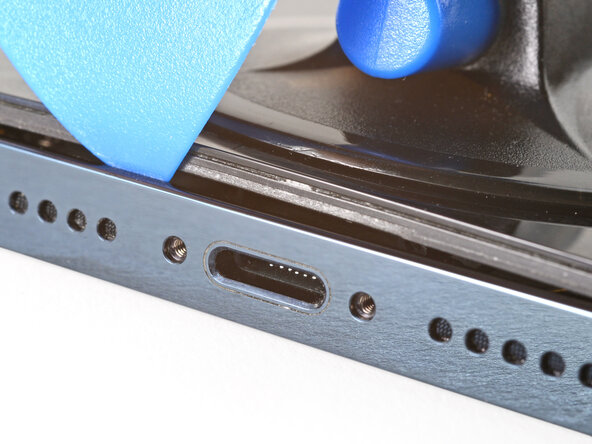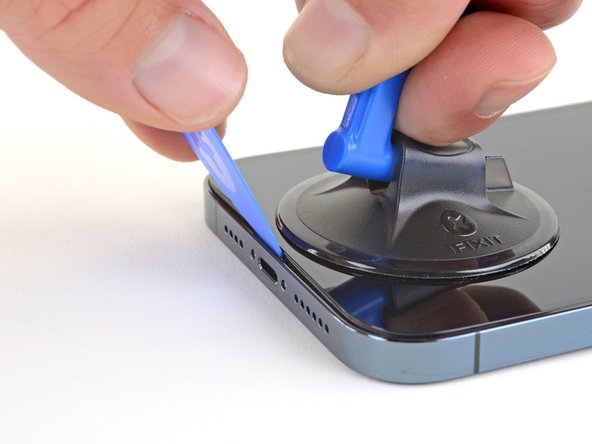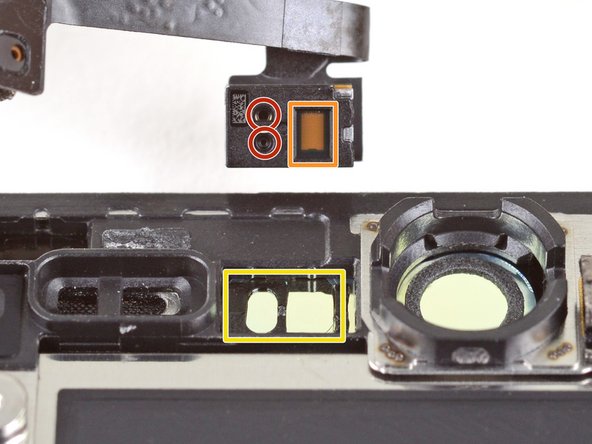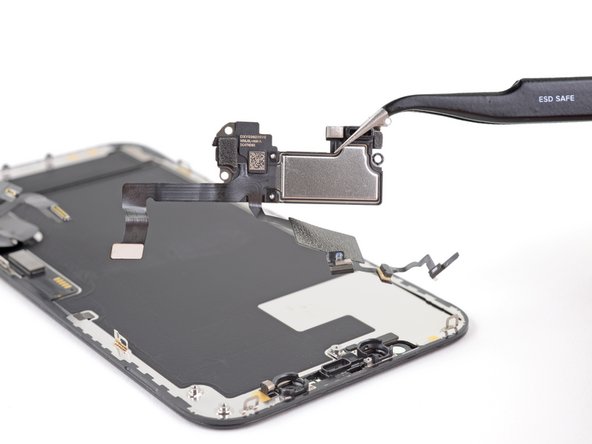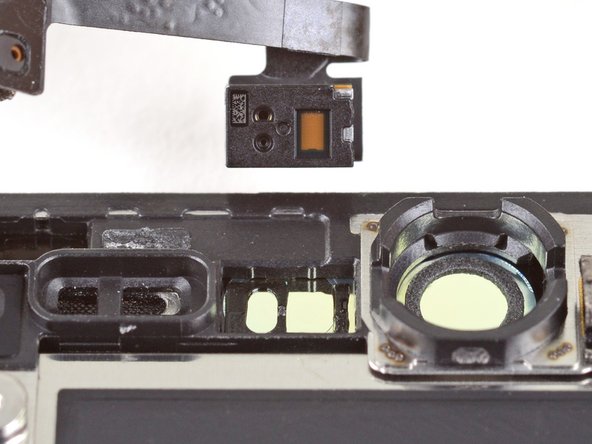iPhone 12 Pro Earpiece Speaker and Front Sensor Assembly Replacement
Duration: 45 minutes
Steps: 33 Steps
This piece is custom-matched to your iPhone right from the factory, so swapping it is a bit like switching dance partners at the prom—make sure you're ready for it!
Follow along with these steps to carefully remove or transfer the earpiece speaker and front sensor assembly from your iPhone 12 Pro. This little bundle of tech sticks to the back of your display and includes a microphone, ambient light sensor, flood illuminator, and proximity sensor. Since this assembly is uniquely paired to your iPhone at the factory, you’ll need to move it from your old screen to your new one whenever you replace the display. The flood illuminator is a key player in Face ID’s biometric security, so if it gets damaged or isn’t installed just right, Face ID won’t work. Swapping in a new part will also cause Face ID to fail, so handle everything with care. If things go sideways, only Apple or an official Apple-authorized technician can get your Face ID back in action.
Step 1
Heads up: Make sure your iPhone battery is under 25% before you get started. Charged lithium-ion batteries and sharp tools don’t mix—no one wants a surprise spark or a pocket-sized fireworks show.
When you open up your iPhone's display, you're letting the water seals take a little vacation! Make sure you've got some replacement seals on hand before you dive into this step. If you decide to put it back together without new seals, just keep your iPhone away from water like it's a bad date!
- First things first, power down your iPhone before diving in.
- Next, grab your P2 pentalobe screwdriver and take out the two 6.75 mm screws at the bottom edge of the iPhone.
Step 2
Pushing your opening pick in too deep can cause damage—let's avoid that! Mark your pick at the right spot to keep things safe and sound.
Feel free to mark the other corners of your pick with different measurements for extra precision.
Or, if you’re feeling crafty, tape a coin about 3 mm from the tip of your pick to act as a handy depth stopper.
- Grab your trusty permanent marker and measure out 3 mm from the tip of that opening pick. Mark it like a pro!
Step 3
Put on your safety glasses to keep those peepers safe from any sneaky glass shards that might pop out during your repair adventure!
Got a cracked iPhone screen? Keep the mess contained and avoid any mishaps by taping over the glass before you dive into the repair.
If you’re feeling extra resourceful, superglue that suction cup to the screen. It’s not ideal, but it’ll do the trick!
- Stick overlapping strips of clear packing tape across the iPhone’s screen, covering the entire front. You want it fully covered, like a protective shield for your phone.
- If the suction cup isn't doing its job, no worries! Grab a sturdy piece of tape (like duct tape), fold it into a handle, and use that to gently lift the screen.
Step 4
Up next: three steps showing off the Anti-Clamp, our trusty sidekick for making phone opening a breeze. Not rocking the Anti-Clamp? Just jump ahead three steps for a different way to open things up.
Want the full lowdown on using the Anti-Clamp? Check out the guide linked above.
If your iPhone is slicker than a greased-up otter and the Anti-Clamp can’t get a grip, slap on some tape for instant traction.
- Give that blue handle a gentle pull backward to loosen up the Anti-Clamp’s arms.
- Slide those arms over either side of your iPhone—left or right, dealer’s choice.
- Line up the suction cups near the bottom of your phone—one facing the front, one on the back.
- Press the cups together to get a solid grip right where you want it.
Step 5
- Give that blue handle a gentle pull towards you to secure those arms in place.
- Now, twist that handle in a full circle—360 degrees—until you see those suction cups starting to stretch. You've got this!
- Keep an eye on those suction cups to make sure they stay buddies. If they start to drift apart, just loosen them a bit and nudge those arms back into alignment. Easy peasy!
Step 6
Go slow—just give it a quarter turn at a time, then chill for a minute before you crank again. Let the Anti-Clamp do its thing and take the pressure off your hands.
To get the full scoop on using a hair dryer the right way, check out this guide.
If the Anti-Clamp isn’t opening up enough space, just warm it up a bit more and twist the handle about a quarter turn.
- Give your iPhone a cozy spot on a sturdy hardcover book so it can chill hands-free and lie flat; this makes it way easier to tackle the next steps.
- Warm up the bottom edge of your iPhone with a hair dryer until it feels slightly too hot to touch. You're doing great!
- Take a breather for one minute to let the adhesive loosen up and create a little opening gap.
- Slide an opening pick under the plastic screen bezel once the Anti-Clamp has made enough space for you.
- Feel free to skip the next three steps!
Tools Used
Step 7
Keep your hair dryer moving—parking it in one spot is a no-go!
- Grab your trusty hair dryer or heat gun and give the bottom edge of your iPhone a warm hug for about 90 seconds. You want it to be nice and toasty, just enough that it feels a little too hot to touch, but not enough to roast your fingers!
Tools Used
Step 8
- Grab your single suction handle and stick it near the bottom edge of the phone—just steer clear of the very edge of the glass to keep things smooth.
Tools Used
Step 9
Be sure to slide that opening pick under the thick plastic bezel with care to keep your screen safe and sound! Look for a little visual gap to know you're on the right track, and make sure the pick isn't snagging on anything. If that gap is playing hard to get, give the screen a gentle pull to create some space.
The adhesive that keeps the screen firmly in place is no joke; it’s really strong! So, getting that first gap open will take some elbow grease. If you’re struggling, don’t stress—just apply a bit more heat and gently wiggle the screen up and down. This will help loosen the adhesive enough to get your tool in there. Patience is key!
- Give that suction cup a gentle tug—steady and strong—to open up a little space between the screen and the frame.
- Slide in an opening pick at a sharp angle into that newly created gap.
Step 10
- Grab your trusty hair dryer and give the right edge of your iPhone a little warm-up action! Aim for about 90 seconds or until it feels just a tad too hot to handle. We're talking that cozy, toasty vibe!
Tools Used
Step 11
Keep your pick shallow—don't go in past 3 mm, or you might poke something that doesn't want to be poked!
- Gently work your opening pick around the bottom right corner of the iPhone to break the adhesive seal. Take it slow – patience is key!
- Keep gliding the pick up along the right edge until you hit the top right corner. Steady does it, you're almost there!
- Leave the pick snug in the top right corner before moving on to the next step. You've got this!
Step 12
- Grab your hair dryer and give the top edge of your iPhone a spa day—heat it up for 90 seconds until it’s just a bit too warm to comfortably touch. This gets things loosened up for the next step!
Tools Used
Step 13
Be careful not to insert your pick more than 3 mm, as it could risk damaging the top sensors. Keep it light, keep it right!
- Gently glide the opening pick around the top right corner of your iPhone to break free that stubborn top adhesive.
- Keep the pick in the top left corner while you continue on your repair adventure!
Step 14
- Grab your trusty hair dryer and give the left edge of your iPhone a warm hug for about 90 seconds, or until it’s feeling a bit toasty to the touch.
Tools Used
Step 15
Careful now! There are some sensitive cables hanging out along the left side of your iPhone. It's best to keep your pick away from this area to avoid any accidental damage to those little guys.
Step 16
Gently apply a twisting motion – slow and steady wins the race.
If the adhesive is putting up a fight, try reheating the left edge for a bit more leverage.
- Pop a second opening pick into the bottom left corner of your iPhone.
- Gently twist both picks at the same time until you hear the satisfying snap of the left edge clips releasing.
Step 17
Hold up before you go yanking the display off—there are some delicate ribbon cables still hanging on.
- Turn your iPhone so that the right edge is facing you.
- Now, gently open your iPhone by lifting the display from the right side, like you’re opening a book. Easy does it!
- Prop the display up against something solid while you work on the phone. Just make sure it stays put.
- When you’re putting everything back together, start by laying the display in place. Line up the clips along the top edge, and carefully press the top edge into position before snapping the rest of the display down. If it’s not clicking easily, double-check the clips around the display’s perimeter to make sure they aren’t bent.
Step 18
Keep a close eye on every single screw during this repair, making sure each one returns to its original spot—mixing them up could turn your iPhone into a puzzle you don’t want to solve.
- Take out the two 1.1 mm long Y000 screws that are keeping the battery and display connector cover in place. Tiny screws, big responsibility.
- When you’re putting things back together, this is a prime moment to fire up your iPhone and make sure everything’s working before sealing up the display. Just remember to fully power it off again before you keep tinkering.
Step 19
- Pop off the cover with a gentle twist—no need to wrestle with it!
Step 20
Be careful not to mess up the black silicone seal around this and other board connections. These little guys are your best friends when it comes to keeping water and dust at bay!
- Gently slide a spudger or even a clean fingernail under the battery connector to lift it out of its spot on the logic board.
- Once it's loose, nudge the connector slightly away from the board so it doesn’t accidentally reconnect and power up the phone while you’re working on it.
Tools Used
Step 21
- Gently pry up the display cable connector using a spudger or even your fingernail—no need to be rough, just a little nudge will do.
- When reconnecting these little guys, line up one side carefully and press until you hear a satisfying click, then repeat on the other side. Avoid pressing in the middle—misaligned pins can bend and cause permanent trouble.
Tools Used
Step 22
- Gently use a spudger or just your fingernail to unplug the digitizer cable connector.
- If your screen isn’t responding to touch after putting things back together, try disconnecting the battery and then firmly reconnect this cable. Make sure it snaps in all the way and that there’s no dust or debris blocking the connection.
Tools Used
Step 23
- Grab your Y000 driver and carefully take out the four screws holding down the front sensor connector cover.
- There are three screws, each 1.1 mm long.
- Plus one screw that's a bit longer at 1.4 mm.
Step 24
- Lift the cover up from the left side until you hear the small clip on the right pop free.
- Take off the cover and set it aside.
- When putting it back, slide the right edge clip into its slot first, then swing the rest of the cover down to snap it into place.
Step 25
- Gently pry up the front sensor assembly cable connector using a spudger or your fingernail to unplug it.
Tools Used
Step 26
- Time to say goodbye to the display assembly! Carefully remove it with a gentle touch.
- When you're putting it all back together, take a moment here if you want to swap out that waterproof adhesive around the display edges. It's a small step that can make a big difference!
Step 27
- Start by unscrewing those four little screws holding the speaker/sensor assembly snugly to the back of the display. It's like a mini treasure hunt!
- You'll need two Phillips screws, each measuring 1.4 mm in length. Make sure to keep them safe!
- Next up, grab that one 1.7 mm long shouldered Y000 screw. It's a bit of a special guest!
- And don't forget the final touch: one 1.2 mm long Y000 screw to wrap things up nicely.
Step 28
The speaker is still connected by a super thin ribbon cable. Handle it with care to avoid any strain or damage to the cable.
The earpiece speaker is just lightly stuck in place, so it should come off without much fuss.
- Grab your trusty spudger and gently nudge the top edge of that speaker up like you're coaxing a shy puppy out from under the couch.
- Now, flip the speaker assembly over, guiding it down and away from the top edge of the display like you're showing it the way out of a crowded room.
Tools Used
Step 29
- Grab a hair dryer, heat gun, or an iOpener and gently warm the top front of the display for 1-2 minutes to loosen up the adhesive holding those sensors in place.
Tools Used
Step 30
Be gentle when prying; those light sensor ribbon cables are delicate and love to be treated with care!
- Gently use the pointy end of a spudger to pry and lift the ambient light sensor away from its snug spot in the front panel.
- Slide the spudger carefully under the ambient light sensor and its cable to loosen the adhesive holding the cable in place.
Tools Used
Step 31
- Gently use the pointy end of a spudger to pop the microphone free from its snug little notch in the front panel.
Tools Used
Step 32
- Grab your spudger and gently pop the proximity sensor and flood illuminator module out of its cozy spot in the front panel. Easy does it—no need to rush!
Tools Used
Step 33
- Check your new part against the original—sometimes you’ve got to swap over some bits or peel off sticky layers before popping it in.
- To put your device back together, just reverse the steps you followed to take it apart.
- Don’t toss your old parts in the trash—take them to an R2 or e-Stewards certified recycler to keep things green.
- If things didn’t quite work out, no worries! Try some basic troubleshooting, or if you’re stuck, you can always schedule a repair with the pros.























